Spatial-Temporal Distribution of Soil Salt Crusts under Saline Drip Irrigation in an Artificial Desert Highway Shelterbelt
Abstract
:1. Introduction
2. Materials and Methods
2.1. Study Site
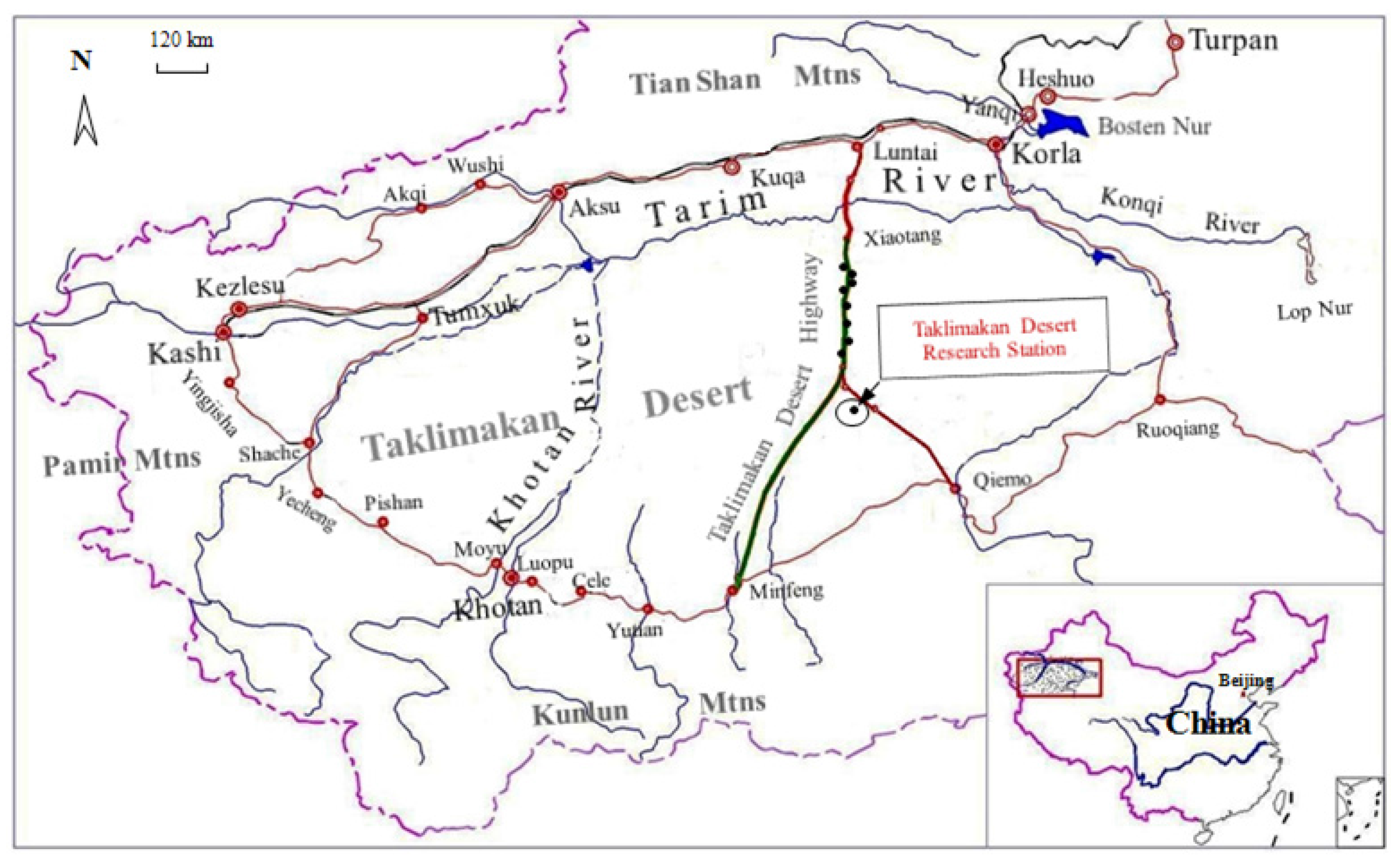
2.2. Experimental Design
2.2.1. Dynamics of Soil Moisture and Salt during a 10-Day Irrigation Cycle
| pH (1:5) | Total Salt Content (g·kg−1) | Ions Composition (g·kg−1) | Particle Composition (%) | |||||||||
|---|---|---|---|---|---|---|---|---|---|---|---|---|
| CO32− | HCO3− | Cl− | SO42− | Ca2+ | Mg2+ | Na+ | K+ | Clay | Silt | Sand | ||
| 8.26 ± 0.432 | 1.33 ± 0.146 | 0.02 ± 0.023 | 0.11 ± 0.052 | 0.70 ± 0.255 | 0.01 ± 0.002 | 0.10 ± 0.023 | 0.01 ± 0.014 | 0.32 ± 0.126 | 0.06 ± 0.030 | 11.41 ± 1.24 | 16.94 ± 5.58 | 71.65 ± 9.82 |
| Sampling Location Number | Location along the Desert Highway (km) | Salinity (g·L−1) | pH | Ion Composition (g·L−1) | |||||
|---|---|---|---|---|---|---|---|---|---|
| HCO3− | Cl− | SO42− | Ca2+ | Mg2+ | K+ & Na+ | ||||
| 1 | 122.99 | 29.70 | 7.80 | 0.23 | 12.18 | 5.99 | 0.76 | 1.08 | 9.43 |
| 2 | 125.00 | 25.90 | 7.98 | 0.20 | 10.54 | 5.47 | 0.73 | 0.96 | 7.46 |
| 3 | 148.80 | 20.99 | 7.58 | 0.19 | 8.97 | 4.85 | 0.69 | 0.83 | 5.40 |
| 4 | 164.80 | 18.36 | 8.09 | 0.17 | 7.84 | 4.24 | 0.60 | 0.73 | 4.74 |
| 5 | 176.00 | 13.99 | 8.02 | 0.13 | 5.98 | 3.23 | 0.46 | 0.55 | 3.61 |
| 6 | 155.80 | 10.00 | 8.02 | 0.09 | 4.37 | 2.14 | 0.24 | 0.31 | 2.84 |
| 7 | 201.10 | 4.82 | 7.85 | 0.07 | 1.80 | 1.07 | 0.10 | 0.25 | 1.52 |
| 8 | 255.20 | 2.82 | 7.40 | 0.06 | 1.07 | 0.69 | 0.07 | 0.09 | 0.83 |
| 9 | TDRS | 4.04 | 7.76 | 0.08 | 1.50 | 1.01 | 0.11 | 0.15 | 1.07 |
2.2.2. SSCs Formation Irrigated at Different Salinities
2.2.3. SSCs Spatial Distribution around the Emitter
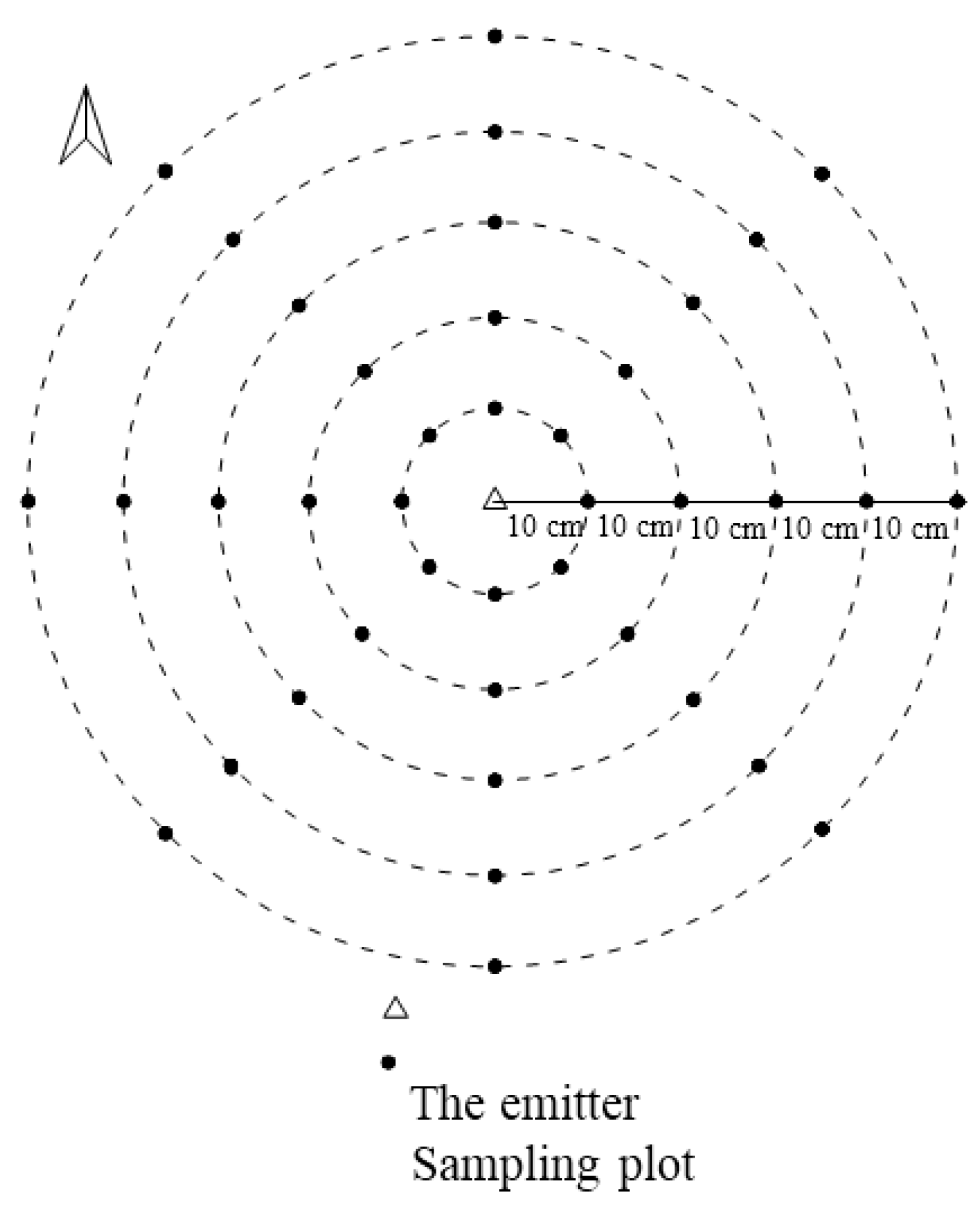
2.2.4. Monthly SSCs Dynamics
2.2.5. Annual SSCs Dynamics
2.3. Analysis of SSC Samples
2.4. Data Analysis and Treatment
3. Results
3.1. Dynamics of Soil Moisture and Salt during One Irrigation Cycle
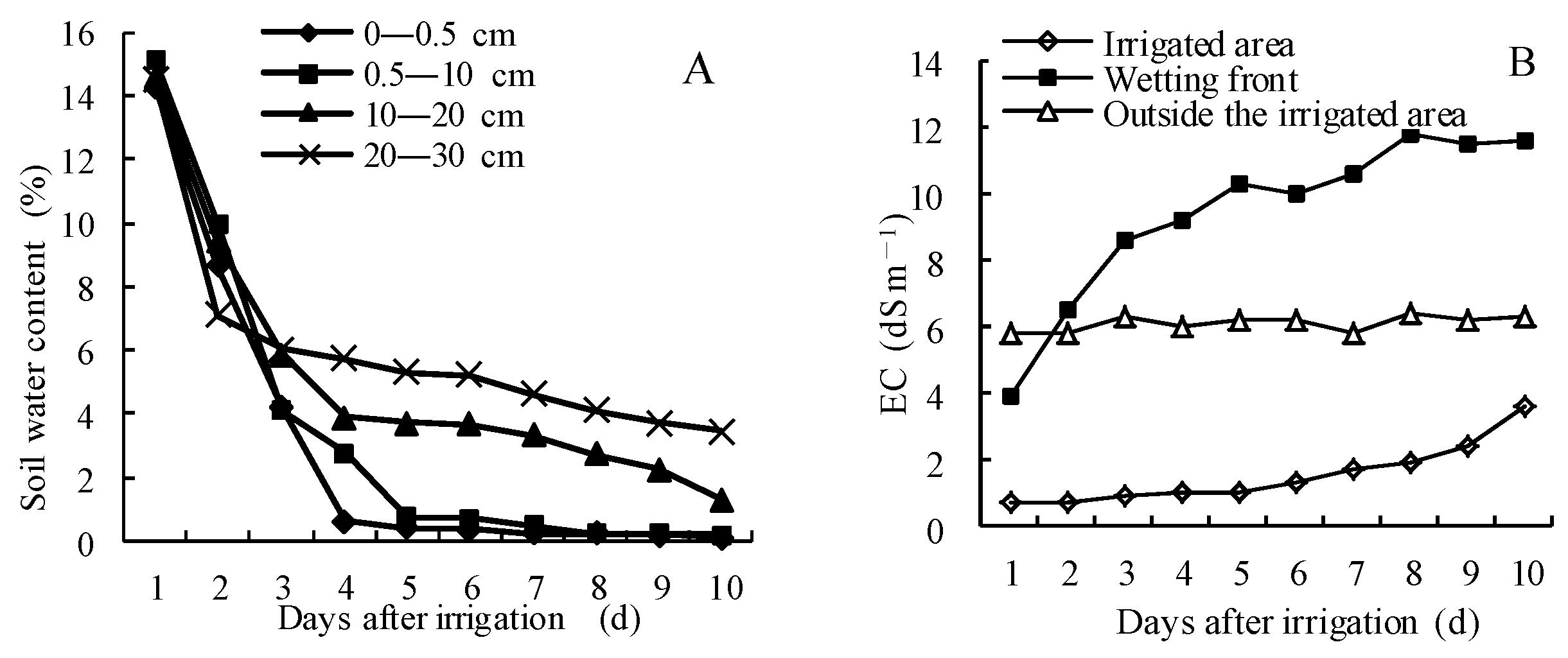
3.2. Effects of Irrigation Water Salinity on SSCs
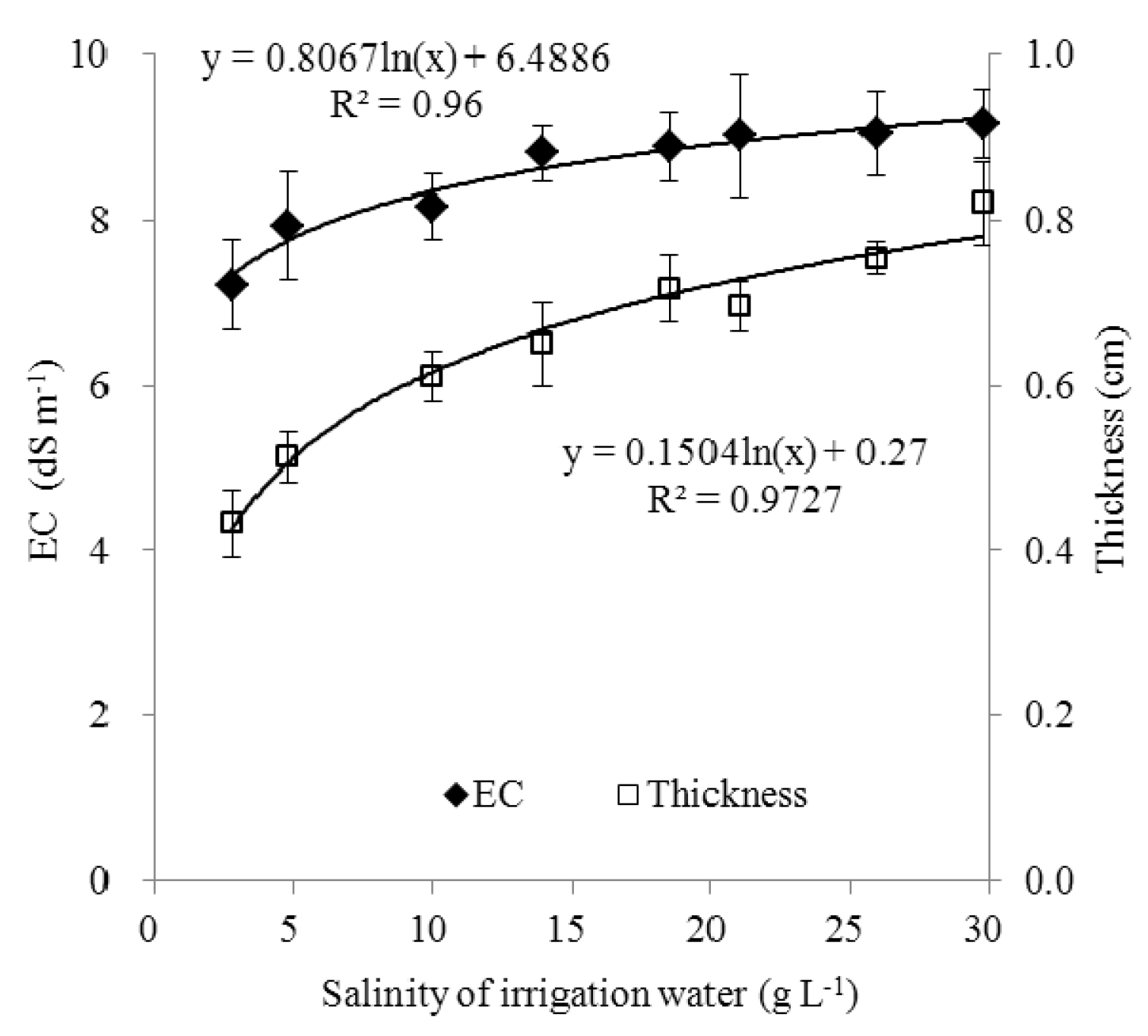
3.3. Spatial Variation in SSCs Affected by Emitting Positions
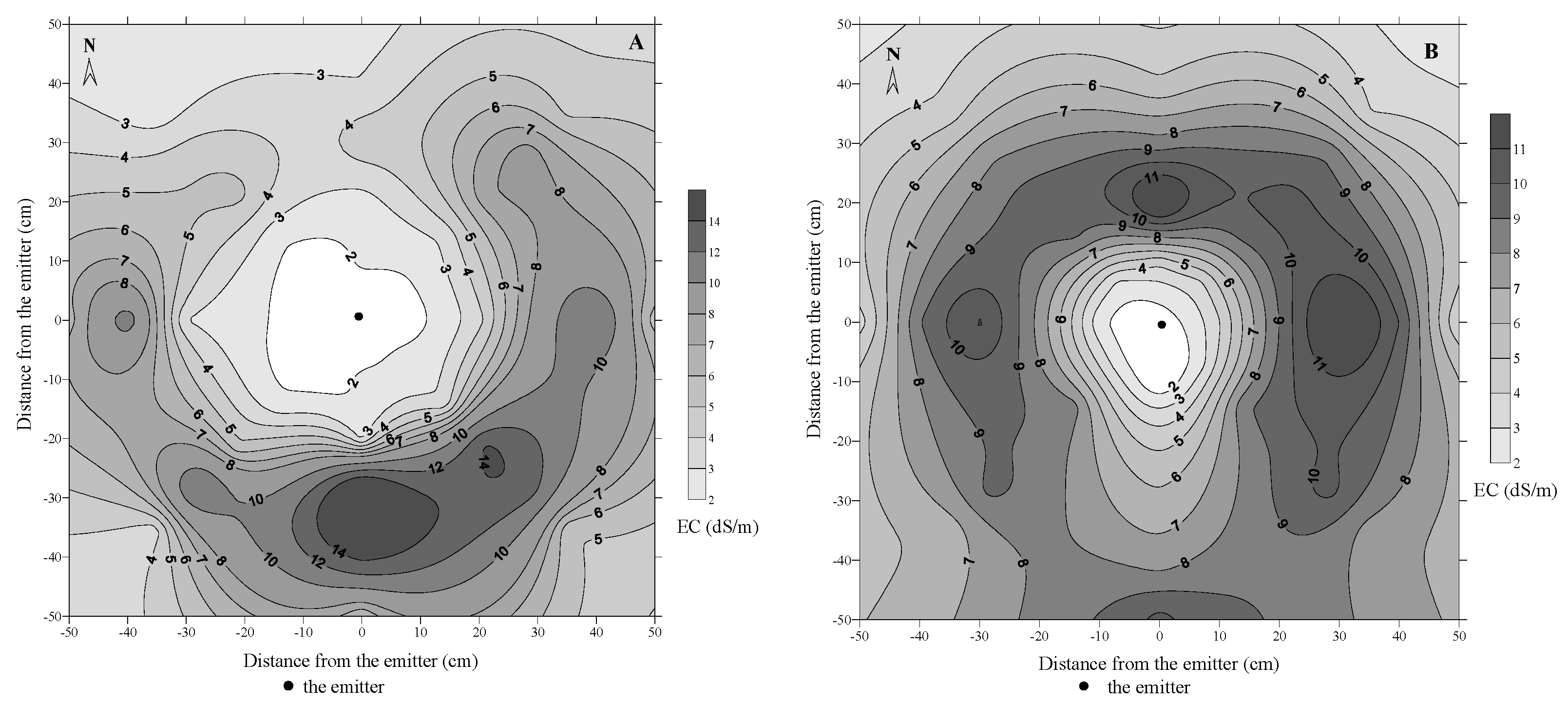
3.4. Monthly Variations
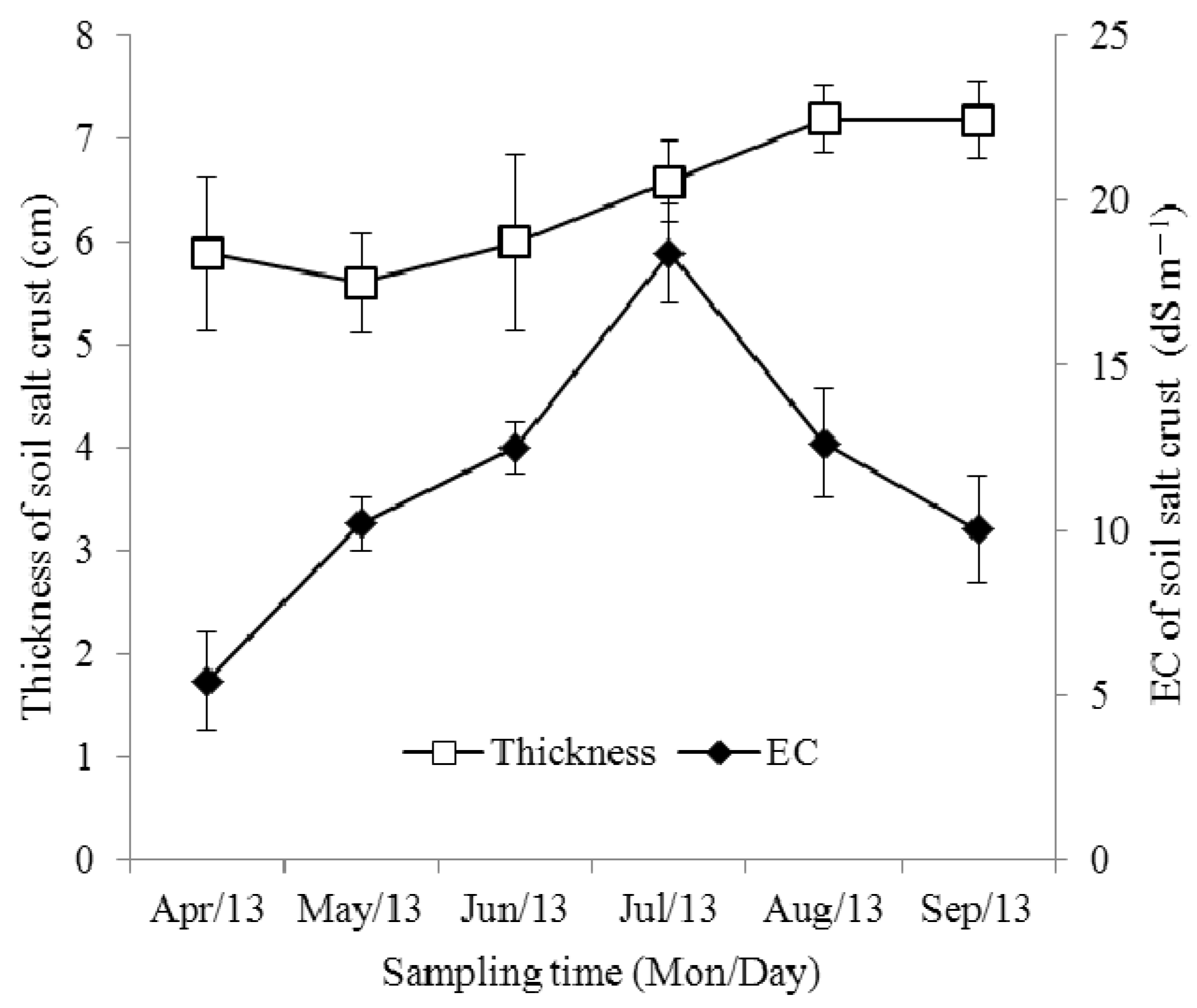
3.5. Effects of Shelterbelt Age on SSCs
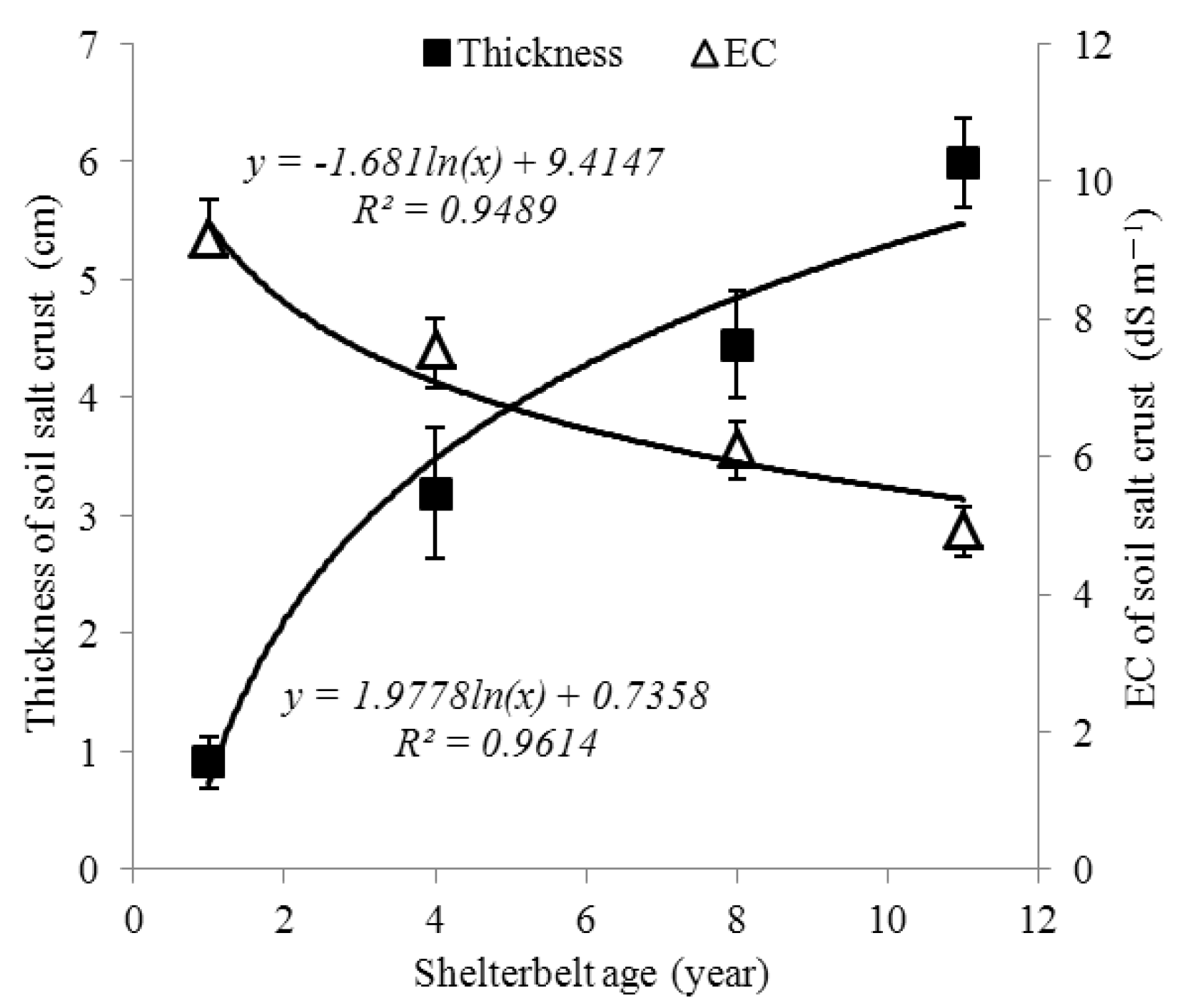
4. Discussion
4.1. Temporal Distribution of SSCs
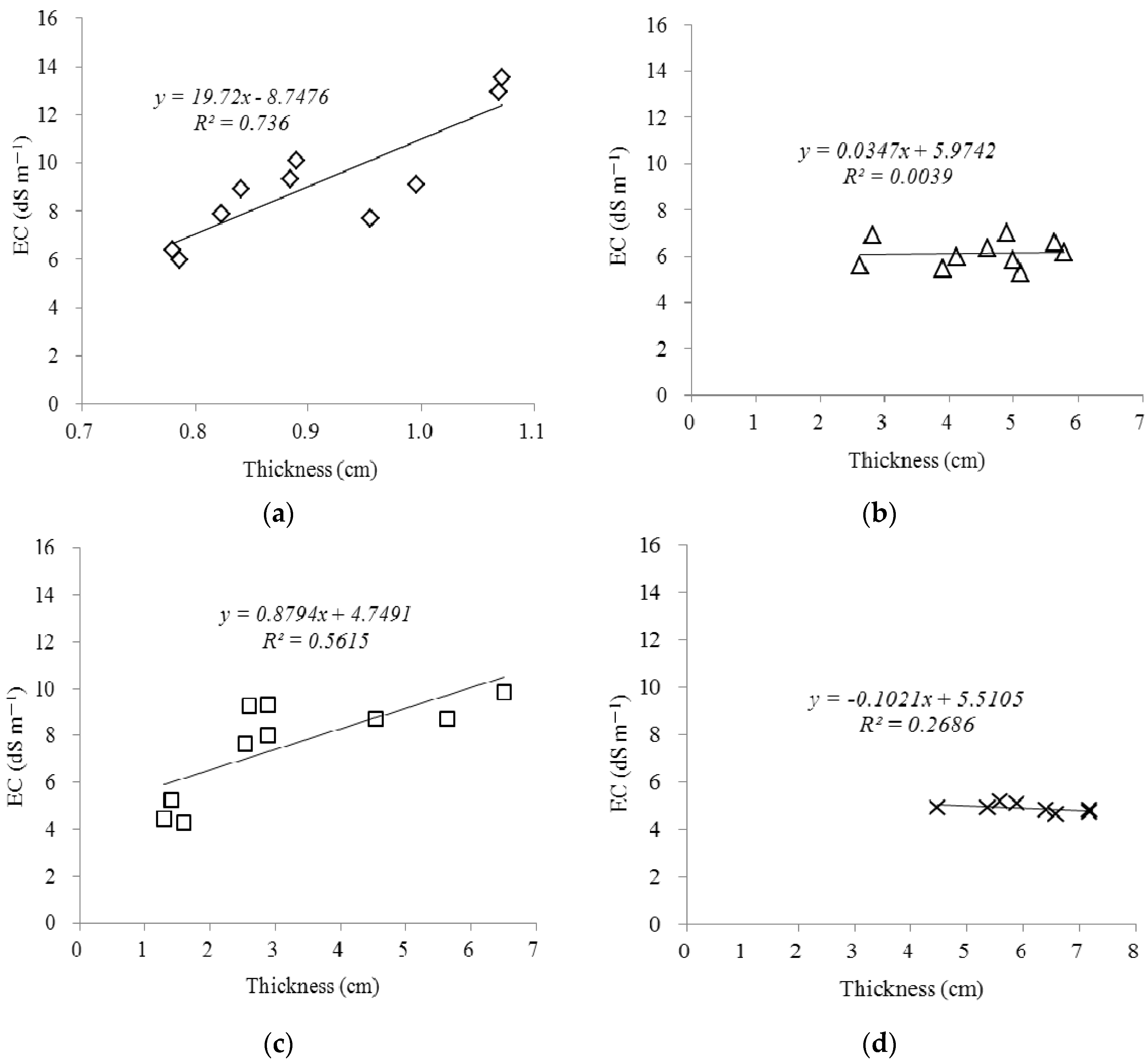
4.2. Spatial Distribution of SSCs
4.3. Response of SSCs to Irrigation Water and Other Factors
4.4. Role of SSCs in Shelterbelts
5. Conclusions
Acknowledgments
Author Contributions
Conflicts of Interest
References
- Goodall, T.M.; North, C.P.; Glennie, K.W. Surface and subsurface sedimentary structures produced by salt crusts. Sedimentology 2000, 47, 99–118. [Google Scholar] [CrossRef]
- Howari, F.M.; Goodell, P.C.; Miyamoto, S. Spectral properties of salt crusts formed on saline soils. J. Environ. Qual. 2002, 31, 1453–1461. [Google Scholar] [CrossRef] [PubMed]
- Zhang, J.G.; Xu, X.W.; Lei, J.Q.; Li, S.Y.; Hill, R.L.; Zhao, Y. The effects of high salinity irrigation and shelterbelt age on the formation of soil salt crusts and soil evaporation in the Taklimakan Desert Highway Shelterbelt of Northwest China. J. Soil Sci. Plant Nutr. 2013, 13, 1019–1028. [Google Scholar]
- Joeckel, R.M.; Clement, B.A. Surface features of the Salt Basin of Lancaster County, Nebraska. Catena 1999, 34, 243–275. [Google Scholar] [CrossRef]
- Mees, F.; Singer, A. Surface crusts on soils/sediments of the southern Aral Sea basin, Uzbekistan. Geoderma 2006, 136, 152–159. [Google Scholar] [CrossRef]
- Santos, J.S.; Oliveira, E.; Bruns, R.E.; Gennari, R.F. Evaluation of the salt accumulation process during inundation in water resource of Contas river basin (Bahia-Brazil) applying principal component analysis. Water Res. 2004, 38, 1579–1585. [Google Scholar] [CrossRef] [PubMed]
- Li, S.; Lei, J.; Xu, X.; Li, B.; Wang, X. Characteristics of salt crust layers in the forests irrigated with saline water in mobile desert. J. Beijing For. Univ. 2007, 29, 41–49. [Google Scholar]
- Grünberger, O.; Macaigne, P.; Michelot, J.; Hartmann, C.; Sukchan, S. Salt crust development in paddy fields owing to soil evaporation and drainage: Contribution of chloride and deuterium profile analysis. J. Hydrol. 2008, 348, 110–123. [Google Scholar] [CrossRef]
- Lei, J.Q.; Li, S.Y.; Jin, Z.Z.; Fan, J.L.; Wang, H.F.; Fan, D.D.; Zhou, H.W.; Gu, F.; Qiu, Y.Z.; Xu, B. Comprehensive eco-environmental effects of the shelter-forest ecological engineering along the Tarim Desert Highway. Chin. Sci. Bull. 2008, 53, 190–202. [Google Scholar] [CrossRef]
- Zhang, J.G.; Xu, X.W.; Lei, J.Q.; Sun, S.G.; Fan, J.L.; Li, S.Y.; Gu, F.; Qiu, Y.Z.; Xu, B. The salt accumulation at the shifting aeolian sandy soil surface with high salinity groundwater drip irrigation in the hinterland of the Taklimakan Desert. Chin. Sci. Bull. 2008, 53, 63–70. [Google Scholar] [CrossRef]
- Shimojimaa, E.; Yoshioka, R.; Tamagawa, I. Salinization owing to evaporation from bare soil surfaces and its influence on the evaporation. J. Hydrol. 1996, 178, 109–136. [Google Scholar] [CrossRef]
- Fujimaki, H.; Shimano, T.; Inoue, M.; Nakane, K. Effect of a salt crust on evaporation from a bare saline soil. Vadose Zone J. 2006, 5, 1246–1256. [Google Scholar] [CrossRef]
- Bao, S.D. Soil and Agrochemical Analysis; China Agriculture Press: Beijing, China, 2000. [Google Scholar]
- Fan, J.L.; Xu, X.W.; Lei, J.Q.; Zhao, J.F.; Li, S.Y.; Wang, H.F.; Zhang, J.G.; Zhou, H.W. The temporal and spatial fluctuation of the ground-water level along the Tarim Desert Highway. Chin. Sci. Bull. 2008, 53, 53–62. [Google Scholar]
- Wang, H.F.; Lei, J.Q.; Li, S.Y.; Fan, J.L.; Li, Y.G.; Sun, S.G.; Chang, Q. Effect of the shelterbelt along the Tarim Desert Highway on air temperature and humidity. Chin. Sci. Bull. 2008, 53, 41–52. [Google Scholar] [CrossRef]
- Zhang, J.; Xu, X.; Lei, J.; Li, S. Effects of salt crust on soil evaporation condition with saline-water drip-irrigation in extreme arid region. Trans. CSAE 2010, 26, 34–39. [Google Scholar]
- Yang, Z.; Chen, W.; Chen, G.; Dong, Z. Characteristics of the weather in the hinterland of the Taklimakan Desert. J. Desert Res. 1995, 15, 293–298. [Google Scholar]
- Raz-Yaseef, N.; Rotenberg, E.; Yakir, D. Effects of spatial variations in soil evaporation caused by tree shading on water flux partitioning in a semi-arid pine forest. Agric. For. Meteorol. 2010, 150, 454–462. [Google Scholar] [CrossRef]
- Zhou, H.W.; Li, S.Y.; Sun, S.G.; Xu, X.W.; Lei, J.Q.; Liu, S.; Du, W.Y.; Yan, Z.; Wang, Y.C. Effects of natural covers on soil evaporation of the shelterbelt along the Tarim Desert Highway. Chin. Sci. Bull. 2008, 53, 137–145. [Google Scholar] [CrossRef]
- Zhang, J.; Zhao, Y.; Xu, X.; Lei, J.; Li, S.; Wang, Y. Effect of shifting sand burial on evaporation reduction and salt restraint under saline water irrigation in extremely arid region. Chin. J. Appl. Ecol. 2014, 25, 1415–1421. [Google Scholar]
- Zhao, X.; Xu, H.; Zhang, P.; Liu, X. Distribution characteristics of salinity in Elaeagnus angustifolia shelterbelt in extreme arid area. J. Soil Water Conserv. 2012, 26, 245–250. [Google Scholar]
- Zhang, P.; Zhao, X.; Zhang, T.; Zhang, G.; Li, B.; Xu, H.; Ye, M. Leaching salinity effect of drip irrigation on soil of oasis shelter forests in arid area. Trans. CSAE 2011, 27, 25–30. [Google Scholar]
- Sun, Y.; Li, S.; Xu, X.; Zhang, J.; Li, Y. Effects of the grain size and thickness of dust deposits on soil water and salt movement in the hinterland of the Taklimakan Desert. Chin. J. Appl. Ecol. 2009, 20, 1905–1911. [Google Scholar]
- Jia, B.Q.; Zhang, H.Q.; Zhang, Z.Q.; Ci, L.G. The study on the physical and chemical characteristics of sand soil crust in the Minqin County, Gansu Province. Acta Ecol. Sin. 2003, 23, 1442–1448. [Google Scholar]
- Langston, G.; Neuman, C.M. An experimental study on the susceptibility of crusted surfaces to wind erosion: A comparision of the strength properties of biotic and salt crusts. Geomorphology 2005, 72, 40–53. [Google Scholar] [CrossRef]
- Maurer, T.; Herrman, L.; Stahr, K. Wind erosion characteristics of Sahelian surface types. Earth Surf. Proc. Landf. 2010, 35, 1386–1401. [Google Scholar] [CrossRef]
- Zhang, J.; Xu, X.; Lei, J.; Li, S. Injury of unexpected strong precipitation to Calligonum under different factors: A case of the shelterbelt eco-project along the Tarim Desert highway. Arid Land Geogr. 2009, 32, 346–352. [Google Scholar]
© 2016 by the authors; licensee MDPI, Basel, Switzerland. This article is an open access article distributed under the terms and conditions of the Creative Commons by Attribution (CC-BY) license (http://creativecommons.org/licenses/by/4.0/).
Share and Cite
Zhang, J.; Wang, Y.; Zhao, Y.; Xu, X.; Lei, J.; Li, S. Spatial-Temporal Distribution of Soil Salt Crusts under Saline Drip Irrigation in an Artificial Desert Highway Shelterbelt. Water 2016, 8, 35. https://doi.org/10.3390/w8020035
Zhang J, Wang Y, Zhao Y, Xu X, Lei J, Li S. Spatial-Temporal Distribution of Soil Salt Crusts under Saline Drip Irrigation in an Artificial Desert Highway Shelterbelt. Water. 2016; 8(2):35. https://doi.org/10.3390/w8020035
Chicago/Turabian StyleZhang, Jianguo, Yongdong Wang, Ying Zhao, Xinwen Xu, Jiaqiang Lei, and Shengyu Li. 2016. "Spatial-Temporal Distribution of Soil Salt Crusts under Saline Drip Irrigation in an Artificial Desert Highway Shelterbelt" Water 8, no. 2: 35. https://doi.org/10.3390/w8020035






